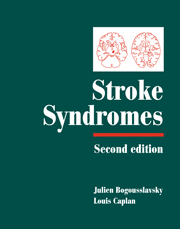Book contents
- Frontmatter
- Contents
- List of contributors
- Preface
- PART I CLINICAL MANIFESTATIONS
- PART II VASCULAR TOPOGRAPHIC SYNDROMES
- 29 Arterial territories of human brain
- 30 Superficial middle cerebral artery syndromes
- 31 Lenticulostriate arteries
- 32 Anterior cerebral artery
- 33 Anterior choroidal artery territory infarcts
- 34 Thalamic infarcts and hemorrhages
- 35 Caudate infarcts and hemorrhages
- 36 Posterior cerebral artery
- 37 Large and panhemispheric infarcts
- 38 Multiple, multilevel and bihemispheric infarcts
- 39 Midbrain infarcts
- 40 Pontine infarcts and hemorrhages
- 41 Medullary infarcts and hemorrhages
- 42 Cerebellar stroke syndromes
- 43 Extended infarcts in the posterior circulation (brainstem/cerebellum)
- 44 Border zone infarcts
- 45 Classical lacunar syndromes
- 46 Putaminal hemorrhages
- 47 Lobar hemorrhages
- 48 Intraventricular hemorrhages
- 49 Subarachnoid hemorrhage syndromes
- 50 Brain venous thrombosis syndromes
- 51 Carotid occlusion syndromes
- 52 Cervical artery dissection syndromes
- 53 Syndromes related to large artery thromboembolism within the vertebrobasilar system
- 54 Spinal stroke syndromes
- Index
- Plate section
36 - Posterior cerebral artery
from PART II - VASCULAR TOPOGRAPHIC SYNDROMES
Published online by Cambridge University Press: 17 May 2010
- Frontmatter
- Contents
- List of contributors
- Preface
- PART I CLINICAL MANIFESTATIONS
- PART II VASCULAR TOPOGRAPHIC SYNDROMES
- 29 Arterial territories of human brain
- 30 Superficial middle cerebral artery syndromes
- 31 Lenticulostriate arteries
- 32 Anterior cerebral artery
- 33 Anterior choroidal artery territory infarcts
- 34 Thalamic infarcts and hemorrhages
- 35 Caudate infarcts and hemorrhages
- 36 Posterior cerebral artery
- 37 Large and panhemispheric infarcts
- 38 Multiple, multilevel and bihemispheric infarcts
- 39 Midbrain infarcts
- 40 Pontine infarcts and hemorrhages
- 41 Medullary infarcts and hemorrhages
- 42 Cerebellar stroke syndromes
- 43 Extended infarcts in the posterior circulation (brainstem/cerebellum)
- 44 Border zone infarcts
- 45 Classical lacunar syndromes
- 46 Putaminal hemorrhages
- 47 Lobar hemorrhages
- 48 Intraventricular hemorrhages
- 49 Subarachnoid hemorrhage syndromes
- 50 Brain venous thrombosis syndromes
- 51 Carotid occlusion syndromes
- 52 Cervical artery dissection syndromes
- 53 Syndromes related to large artery thromboembolism within the vertebrobasilar system
- 54 Spinal stroke syndromes
- Index
- Plate section
Summary
Anatomy
The posterior cerebral arteries (PCAS) are the major sources of blood supply to the midbrain, thalamus, occipital lobes, inferior and medial temporal lobes, and portions of the posterior inferior parietal lobes. The PCAs originate from the terminal bifurcation of the basilar artery, encircle the midbrain, and then divide into cortical branches as they reach the dorsal surface of the midbrain (Margolis et al., 1974). The peduncular, ambient, and quadrigeminal segments of the PCAs are named after the cisterns through which the arteries pass. The initial portion of a PCA, before the posterior communicating artery anastomosis from the internal carotid artery, is referred to as the PI segment, the mesencephalic artery, or the precommunal portion of the PCA. In about 10% of individuals, a fetal pattern of origin of one PCA from the internal carotid artery will persist into adult life, in which case the PI segment from the basilar artery will be hypoplastic (Hoyt et al., 1974). One PCA may be unusually large (29% of individuals) or unusually small (24%) (Hoyt et al., 1974).
Arterial branches that supply the medial portions of the midbrain and the posteromedial thalamus, including the paramedian mesencephalic arteries, the thalamic subthalamic arteries (also called the thalamoperforating arteries), and the medial posterior choroidal arteries, arise from the peduncular, precommunal segments of the PCAs. The anterior and anterolateral portions of the thalamus are usually fed by the tuberothalamic (polar) arteries, which branch from the posterior communicating arteries, not the PCAs. However, in some patients the tuberothalamic arteries are absent, and their usual territory is supplied by the thalamic-subthalamic arteries.
- Type
- Chapter
- Information
- Stroke Syndromes , pp. 479 - 489Publisher: Cambridge University PressPrint publication year: 2001
- 4
- Cited by



